With its emphasis on breathing exercises and meditation, which assist in quieting and centering the mind, it’s no surprise that yoga for mental health is effective, such as reducing anxiety and sadness. What’s more surprising is that it boosts the performance of your brain.
If you want to enhance your mental health and a general sense of well-being, practicing yoga with an emphasis on deep breathing and gentle stretching may be beneficial. Yoga has several health advantages, ranging from increased bodily awareness to mental clarity and relaxation. It can even help someone’s mental health.
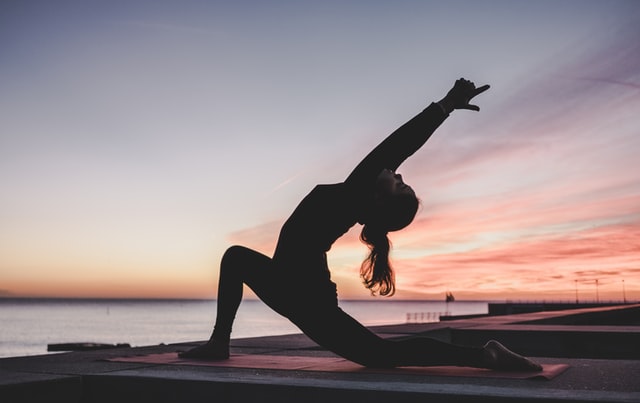
Yoga is one of the oldest types of exercise. While there are many distinct styles, ranging from easy to intense, yoga practice often involves stretching, breathing, and a period of profound relaxation or meditation.
An increasing body of research dating back to the 1970s suggests that yoga might help people manage depression, anxiety, and stress symptoms, among other things.
According to Harvard Medical School, there is accumulating evidence that yoga practice is a low-risk, high-benefit method to improve general health.
The UN International Day of Yoga, celebrated on June 21, aims to increase awareness of the various advantages of yoga for good mental health, both physical and psychological.
Yoga for good mental health and well-being
Yoga is a physical exercise that consists of various body positions, breathing methods, and meditation.
Yoga practice regularly may aid in:
- Stress relief
- Reduce your anxiety levels
- Reduce depression
- Improve your sleep quality.
- Improve your quality of life
Yoga for mental health is considered to provide these advantages in a variety of ways:
- As a result of doing any physical activity, serotonin is naturally produced, commonly referred to as the “happy chemical” since it leads to emotions of well-being and pleasure. Serotonin is a natural mood stabilizer in the brain that has been related to the management of anxiety and stress.
- Regular yoga practice promotes severe attention and mindful breathing, which are crucial in treating depression. Participants can improve their present-moment attention, cleanse their minds, and increase their mind-body connection.
- Holding positions for lengthy periods tests both mental and physical endurance. It improves stamina, strength, and flexibility.
- It helps control the stress response by decreasing heart rate, blood pressure, and breathing. It may also aid in the management of pain tolerance.
Yoga for good Mental Health
When the lockdown was initially implemented, it altered everyone’s daily routine in three significant ways: the restriction on travel and maintaining social distance outside the home to the minimal availability of most public services, with only the essentials spared. This abrupt and extreme change in daily routine has affected many individuals.
Furthermore, the rapid loss of jobs and financial hardship have had a psychological impact on the working population, as seen by heightened hostility and post-traumatic stress signs.
Also, people exposed to potential sources of infection daily, such as doctors, health caregivers, police, reporters, and other front-line workers, are more likely to be stressed because they risk becoming infected and infecting their family and loved ones with the virus.

In these uncertain times, therapists, psychologists, and psychiatrists worldwide report increased awareness of mental health issues such as anxiety and depression. They mostly recommend adopting preventive measures and non-medicated treatments to try before seeking help from medications. Yoga is one such time-saving approach that relieves stress and aids in treating insomnia, anxiety, and depression symptoms.
Regularly practicing specific yogasanas will strengthen your endurance and confidence and help relax the mind, boost mood, and eventually build immunity.
Let us first introduce you to different types of yoga:
1. Hatha
It incorporates gentler, slower-paced movements that are best suited for beginners. This course exposes novices to the basic relaxation methods and asanas used in yoga.
2. Vinyasa
It connects breathing and movement; the pace begins slowly and eventually increases. Vinyasa seeks to improve strength and lean muscle mass throughout the body.
3. Bikram
It takes place in a heated environment where you do a specific series of motions to enhance blood flow. It consists of low-impact, evenly-paced activities that stretch muscles and improve circulation.
4. Restorative
In this yoga style, you go through five or six poses slowly for an hour to help you relax. This yoga aims to slow down and expand your body through passive stretching. Restorative classes are extremely calming and a fantastic way to decompress.
5. Lyengar
Props like chairs, blocks, and straps are utilized to help you achieve ideal body alignment. Focuses on precision, timing, and support to increase strength and stability.
6. Ashtanga
It is more physically demanding and focuses on rapid, sequenced postures. It is a high-energy, intense form meant to make you sweat.
Let us try out some of the yoga poses to ease stress
1. Siddhasana aka accomplished pose
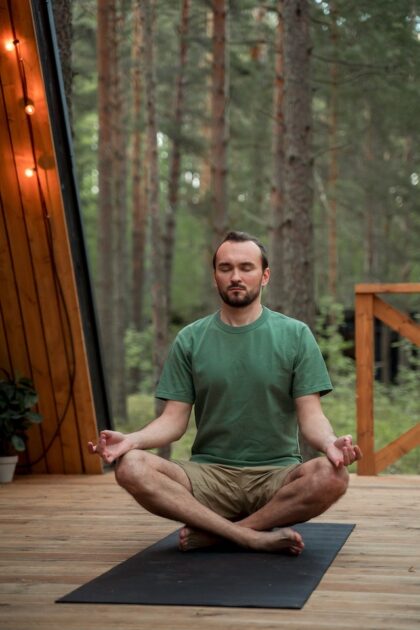
It is the most basic yoga stance, in which you sit cross-legged with your eyes closed in intense concentration and your hands resting on your knees. To perfect the sitting asana, sit in a thoughtful position with your toes tucked into your thighs and feet side by side, knees wide and eyes closed.
Benefits:
- Siddhasana, also known as Yoga’s Accomplished Pose or Siddhi’s Pose, is an excellent position for meditation. It helps develop hip and groin/inner thigh flexibility.
- It not only stretches the hips, chest, and shoulders of the practitioner, but it also improves posture, strengthens calf muscles, lengthens the spine, activates the chakras, stretches the front of the ankles, reduces anxiety and stress, and keeps the mind alert, and aids in the balance of reproductive organ activities.
2. Balasana (Baby Pose)

Get down on your knees and maintain your spine straight. Slowly lean forward until both thighs meet the chest. Bend forward till your head is over your knee and touches the ground. Straighten both of your arms rearward on either side of your legs, palms facing the floor. Hold this posture for 20-25 seconds, then take a few seconds off and repeat 2-3 times.
Benefits:
- The Baby Pose is beneficial for extending the entire body, especially the hip joint and muscles.
- It improves general balance and stamina, improves blood circulation, and tones the muscles in the hip, ankle, and thigh areas.
- Regular practice not only reduces tension and anxiety but also maintains tranquillity and a stress-free mind.
3. Viparita Karani (Legs Up The Wall Pose)
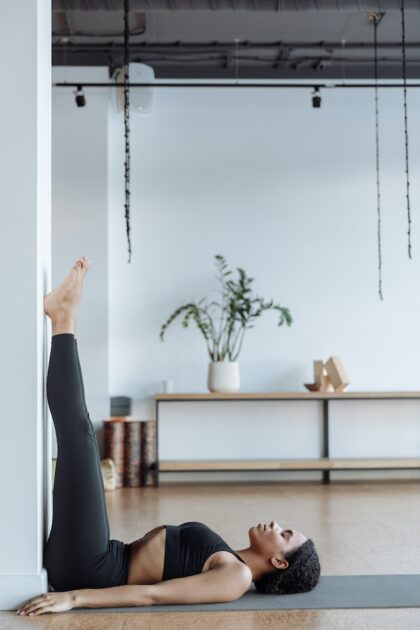
Sit around 3 inches away from an empty wall at first. Lie on your back and swing your legs up such that the back of your thigh rests against the wall. Then relax your arms on either side of the body or your stomach, and place your entire back, or spinal column, on the floor below. Hold the posture for 10 minutes, or as long as you can, before gently bringing your leg back to the beginning position.
Benefits:
- Viparita Karani, one of the soothing positions, allows you to rest flat on the ground with your legs up without any twisting.
- It is a helpful yogasana that permits lymphatic drainage, evens out blood circulation, lowers ankle edema, and addresses arthritis, sciatica, and lupus illnesses.
- It also relieves anxiety, heals depression and sleeplessness, and successfully revitalizes the mind and body.
4. Uttanasana (Forward Bend Pose)

Bring your feet hip distance apart when standing. Slowly bend your body above the chest downwards without bending your legs. Make sure your knees are straight. Allow your hands to dangle down and lay your palms on the ground, or keep your feet close to your ankles. Hold this position for 8-10 breaths before gently returning to a standing position.
Benefits:
- This inverted posture is particularly beneficial since it boosts immunity, reduces stress, and calms the mind.
- It brings prana and blood flow to the sinuses, which reduces congestion and aids in the removal of catarrh particles from the body.
- It also strengthens the calves, hamstrings, and hips while alleviating insomnia, weariness, and headache.
5. Setubhandhasana/Setu Bandha Sarvangasana aka the Bridge pose

Just lay down on your back with your legs straight on the floor and your palms beside your thighs. To move your heels closer to your hips, bend both knees while maintaining your legs and hips apart.
Inhale and raise your stomach and chest off the floor, lifting your hips off the floor. With your hands, support your lower back. Straighten your legs with your toes pointed forward. Hold for 10 to 15 seconds before releasing.
Benefits:
- The Bridge posture, also known as this version, extends the chest, neck, and spine.
- It strengthens the back, buttocks, and hamstrings, improves blood circulation, reduces tension, and relaxes the mind.
6. Paschimottanasana aka seated forward-bend
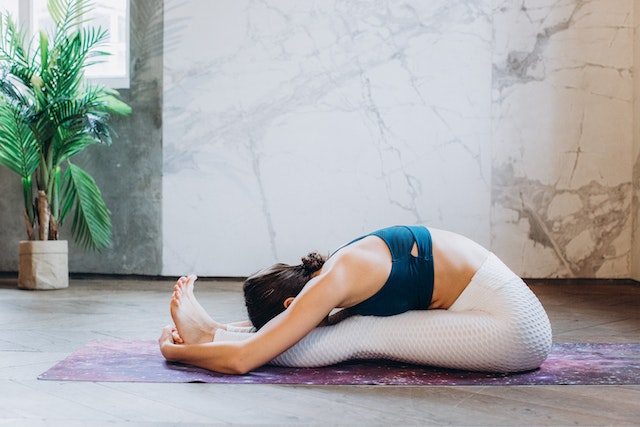
Begin with Dandasana and wrap a strap over your feet, gripping them with your hands if your back is stiff. Bend slightly in your knees and a widespread of your legs in front of you.
Inhale, then raise your arms straight out to the sides and up over your head, reaching for the ceiling while maintaining your spine upright. As you exhale and empty the air of your stomach, begin to come forward by hinging at your hips and resting your upper body on your lower body.
You have to lower your arms, reach for your big toes with your fingertips, and try to touch your knees with your nose. Remember to stretch your spine with each inhalation and deepen into your forward bend with each exhalation.
Benefits:
- Although it sounds easy, it offers various benefits, particularly for people with high blood pressure and diabetes. One of the most significant health benefits is that it relaxes and soothes the mind and body.
- It also promotes the flow of fresh blood to the brain, which helps to calm the mind and lowers restlessness, melancholy, and worry.
7. Anjaneyasana aka Low Lunge or Crescent Moon Pose
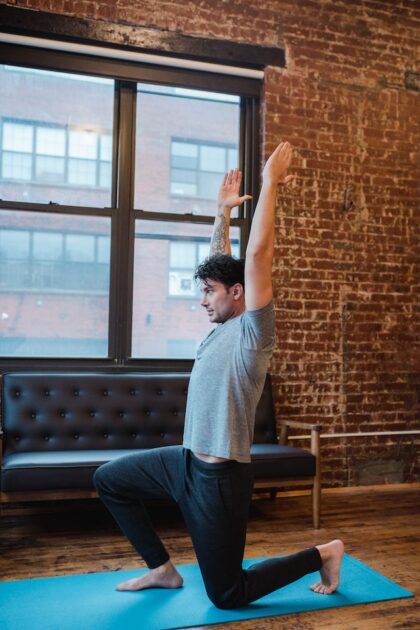
Inhale and raise your chest erect, either parallel or palms united, high your arms. Bend deeper into the posture with each exhalation, tucking your tailbone into the floor. Take a step back and, if possible, look up. Return to the downward dog and repeat on the opposite side to exit the pose.
Benefits:
- This asana increases flexibility in your shoulders and neck. The posture stretches the hips, thighs, and groins deeply.
- It helps stretch and expand the chest and shoulders, promotes post-workout recovery, and increases energy while deliberately improving body posture.
- The asana also enhances the body’s equilibrium.
8. Shavasana (Corpse Pose)
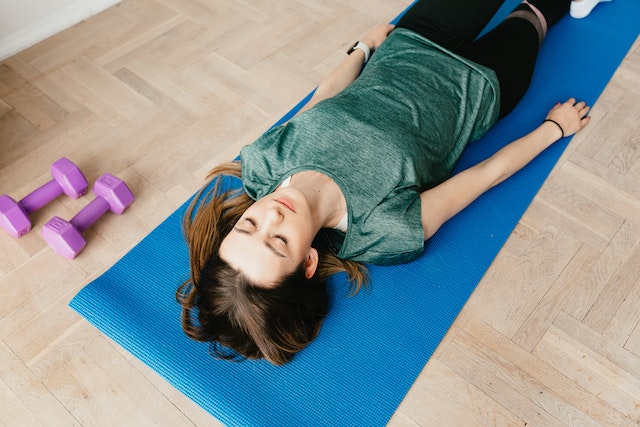
Close your eyes and lie down on your back. Relax your entire body and mind. and think positive, pleasant thoughts. Take your time when doing this. Breathe regularly, without holding your breath. Stand up after a while.
Benefits:
- This yogasana cools the body, relaxes the mind, and marks the conclusion of the yoga practice.
- It also prevents gastrointestinal problems, diabetes, and respiratory problems. After each asana, it should be done to enable the body to rest in between asanas.
Conclusion
If you want to attempt yoga to enhance your mental health and well-being, bear in mind that it should be viewed as a supplement to your current therapies, such as medicine and psychotherapy.
Yoga is accessible in various forms and is suitable for people of all ability levels. When you first experiment with several styles, find the one that works best for you.
If your mental health is deteriorating and you need help, visit our blog mental help first aid- basics.
Let us discuss in the comments which yoga poses have you been trying and would want to suggest to our other readers.
Take care of your mental health every day, and keep reading our blog posts.

